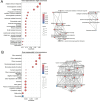Transcriptomic Features of Recurrence Rates in Idiopathic Subglottic Stenosis
- PMID: 40326273
- PMCID: PMC12371795
- DOI: 10.1002/lary.32214
Transcriptomic Features of Recurrence Rates in Idiopathic Subglottic Stenosis
Abstract
Objective: Idiopathic subglottic stenosis (iSGS) is a rare disease characterized by narrowing of the upper airway and affects near-exclusively females. Patients often experience recurrent disease and require repeated surgical dilations. The pathophysiology underlying the broad spectrum of disease severity within iSGS remains unknown. In the current study, we sought to identify transcriptomic differences between iSGS patients with markedly different recurrence rates.
Methods: Prospectively collected clinical and bulk RNA sequencing data from subglottic tissues of 56 female iSGS patients with 1-4 years of follow-up were analyzed. DESeq2 was used to perform differential expression analysis, comparing samples from the highest (1.19-1.87 dilations/year) versus the lowest (0.30-0.65 dilations/year) quartile of surgical dilation rate (i.e., high vs. low recurrence groups).
Results: In total, 220 genes were significantly differentially expressed between the high and low recurrence groups (adjusted p < 0.1 and log2 fold change > |1|). Pathway enrichment analyses showed that the high recurrence group had significantly increased expression of genes involved in adaptive immune responses (e.g., immunoglobulin subunit genes) and extracellular matrix organization (e.g., COMP, NID2) (adjusted p < 0.1). In contrast, the low recurrence group had significantly increased expression of genes involved in cilia structure and function (e.g., CFAP43, DNAI2) (adjusted p < 0.1), suggesting a relatively increased abundance of respiratory cilia.
Conclusion: Transcriptomic profiling suggests that lower recurrence rates in iSGS are associated with retention of respiratory cilia, while adaptive immune responses and increased extracellular matrix deposition are present in those with higher recurrence rates. These results hold promise for the development of prognostic markers and identification of therapeutic targets for iSGS.
Keywords: B cell; RNA sequencing; adaptive immunity; extracellular matrix; fibrosis; idiopathic subglottic stenosis (iSGS); surgical endoscopic dilation.
© 2025 The Author(s). The Laryngoscope published by Wiley Periodicals LLC on behalf of The American Laryngological, Rhinological and Otological Society, Inc.
Conflict of interest statement
A.C.N. has research funding from Novartis Canada, Merck Canada, LabCorp, and Droplet Biosciences for studies that are unrelated to the submitted work. He has equity from and is a consultant for NEED Inc. M.J.C. has research funding from Astra Zeneca, Merck, and Pfizer. He has received payment for speaker honorarium and/or served on advisory boards for Eli Lilly Merck, Astra Zeneca, and Amgen. M.J.C. has equity from and is a consultant for NEED Inc. A.H.K. has consulted for Merck Inc. and serves on the advisory board for Pentax Inc., both unrelated to the current study. P.Y.F.Z., J.W.B., J.S.M., and A.C.N. hold patents for transcriptional biomarkers in head and neck cancer, unrelated to this work. The other authors declare no conflicts of interest.
Figures


References
MeSH terms
Grants and funding
LinkOut - more resources
Full Text Sources
Miscellaneous

